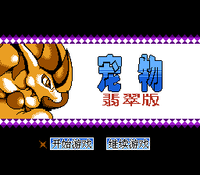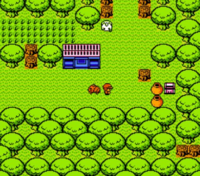Kou Dai Jing Ling - Fei Cui: Difference between revisions
(dWgJZgvzfVvaadBnFN) |
m (fixed waixing link) |
||
| (9 intermediate revisions by 5 users not shown) | |||
| Line 1: | Line 1: | ||
[[File:T1nes_title.png|thumb|200px|Title screen]] | |||
'''Kou Dai Jing Ling - Fei Cui''' (Chinese: 口袋精灵 - 翡翠 ''Kǒudài Jīnglíng - Fěicuì'', ''Pocket Monsters - Jade'') is a bootleg NES port of [[Wikipedia:Keitai Denjū Telefang|''Keitai Denjū Telefang'']] made by [[Waixing]]. | |||
== Overview == | |||
[[File:KouDaiJingLingFeiCuiMap.png|thumb|200px|Overworld]] | |||
While the general plot is still the same, with the same objectives and bosses, there are some drastically altered elements. The starter [[Denjuu]] is [[Oshe]], as opposed to [[Crypto]] (in Power version) or [[Fungus]] (in Speed version). Wild evolved Denjuu are more frequent than in the original games. The maps are changed as well: While the general layout is the same, the acres are far larger: instead of them being 160x128 (the size of a Game Boy Color screen minus the 16-pixel high status bar), they are 256x240 (the size of a PAL NES screen), and everything is adjusted accordingly. Shops are completely different, offering many items at a time, as opposed to just four, and are often very expensive. The clock is completely non-existent. All of the Denjuu are given random Pokémon names (sometimes misspelled). Like all Waixing pirates, the text is in Chinese, rather than Japanese. The first eleven monsters from the third generation of ''Pokémon'' games are present too, thus dating the pirate to 2002 or later. The music in this game is recycled from several other Waixing games; for example, the battle theme is from Waixing's port of ''[[Biohazard]]''. | |||
== Battle system == | |||
The battle system in Kou Dai Jing Ling - Fei Cui is much like Waixing's Famicom ports of Pokémon Red and Yellow, and uses some move animations from them, which were taken from Pokémon Gold/Silver/Crystal. | |||
Like Telefang 1, the player can select up to three Denjuu to battle at a time. Although the Denjuu select screen says they will arrive in 6 turns (which is unlike the original game), they always seem to arrive instantly. Whereas there are 3-on-3 battles, only one Denjuu will battle on a side at a time; however, they can be switched freely, and doing so will not cost a turn. Each Denjuu has four attacks. The attacks all have PP, which is a feature from Pokémon and not ''Keitai Denjū Telefang''. The HP and PP restores after a battle ends. The more powerful Denma attacks, which took several turns to charge up and ran off a separate attack stat, are absent. | |||
In the original game, each Denjuu had a habitat type that affects how it battles against other habitat types. The type matchups were a simple 6-way rock-paper-scissors chain: Forest -> Aquatic -> Desert -> Grassland -> Mountain -> Sky -> Forest. However, they seem to be non-existent here. | |||
== Trivia == | |||
*The title screen uses a bronze-colored depiction of Crypto's fight pose from the intro sequence of ''Keitai Denjū Telefang: Power Version'', and is of a similar shade as the glitched color palette in ''Pokémon Diamond''<nowiki>'</nowiki>s intro. The similarity between the two bronze-colored depictions suggests that <span>Waixing may have been at least partially involved in translating ''Power/Speed'' into ''Diamond/Jade''</span>, or that the company's developers used the GBC bootlegs as the basis for this NES title. These possibilities are strengthened by the fact that both the NES game and the GBC bootlegs attempt to disguise Telefang as an installment in the otherwise unrelated ''Pokémon'' franchise. | |||
*Although the ROM title is ''Kou Dai Jing Ling - Fei Cui'', which means "Pocket Monsters - Jade", the in-game title screen reads ''Chǒngwù - Fěicuì Bǎn'' (寵物 - 翡翠版), which translates as "Pets - Jade Edition". | |||
==See also== | |||
*[[Pokémon Diamond and Jade]] | |||
*[[Bootlegs of Telefang 1]] | |||
*[[Waixing]] | |||
==References== | |||
<references /> | |||
[[Category:Telefang 1 bootlegs]] | |||
[[Category:NES bootlegs]] | |||
Latest revision as of 14:28, 21 May 2024

Kou Dai Jing Ling - Fei Cui (Chinese: 口袋精灵 - 翡翠 Kǒudài Jīnglíng - Fěicuì, Pocket Monsters - Jade) is a bootleg NES port of Keitai Denjū Telefang made by Waixing.
Overview[edit]

While the general plot is still the same, with the same objectives and bosses, there are some drastically altered elements. The starter Denjuu is Oshe, as opposed to Crypto (in Power version) or Fungus (in Speed version). Wild evolved Denjuu are more frequent than in the original games. The maps are changed as well: While the general layout is the same, the acres are far larger: instead of them being 160x128 (the size of a Game Boy Color screen minus the 16-pixel high status bar), they are 256x240 (the size of a PAL NES screen), and everything is adjusted accordingly. Shops are completely different, offering many items at a time, as opposed to just four, and are often very expensive. The clock is completely non-existent. All of the Denjuu are given random Pokémon names (sometimes misspelled). Like all Waixing pirates, the text is in Chinese, rather than Japanese. The first eleven monsters from the third generation of Pokémon games are present too, thus dating the pirate to 2002 or later. The music in this game is recycled from several other Waixing games; for example, the battle theme is from Waixing's port of Biohazard.
Battle system[edit]
The battle system in Kou Dai Jing Ling - Fei Cui is much like Waixing's Famicom ports of Pokémon Red and Yellow, and uses some move animations from them, which were taken from Pokémon Gold/Silver/Crystal.
Like Telefang 1, the player can select up to three Denjuu to battle at a time. Although the Denjuu select screen says they will arrive in 6 turns (which is unlike the original game), they always seem to arrive instantly. Whereas there are 3-on-3 battles, only one Denjuu will battle on a side at a time; however, they can be switched freely, and doing so will not cost a turn. Each Denjuu has four attacks. The attacks all have PP, which is a feature from Pokémon and not Keitai Denjū Telefang. The HP and PP restores after a battle ends. The more powerful Denma attacks, which took several turns to charge up and ran off a separate attack stat, are absent.
In the original game, each Denjuu had a habitat type that affects how it battles against other habitat types. The type matchups were a simple 6-way rock-paper-scissors chain: Forest -> Aquatic -> Desert -> Grassland -> Mountain -> Sky -> Forest. However, they seem to be non-existent here.
Trivia[edit]
- The title screen uses a bronze-colored depiction of Crypto's fight pose from the intro sequence of Keitai Denjū Telefang: Power Version, and is of a similar shade as the glitched color palette in Pokémon Diamond's intro. The similarity between the two bronze-colored depictions suggests that Waixing may have been at least partially involved in translating Power/Speed into Diamond/Jade, or that the company's developers used the GBC bootlegs as the basis for this NES title. These possibilities are strengthened by the fact that both the NES game and the GBC bootlegs attempt to disguise Telefang as an installment in the otherwise unrelated Pokémon franchise.
- Although the ROM title is Kou Dai Jing Ling - Fei Cui, which means "Pocket Monsters - Jade", the in-game title screen reads Chǒngwù - Fěicuì Bǎn (寵物 - 翡翠版), which translates as "Pets - Jade Edition".